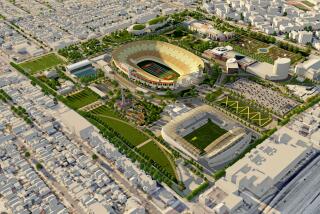Ideas in transit
- Share via
For the most part, the buildings designed for spots near new mass transit lines in Southern California have been pretty underwhelming architecturally. And it’s easy to be cynical about many of them. After all, putting a new apartment building or mixed-use complex close to an existing transit line -- or a transit line that may potentially, possibly be built in the future -- often absolves developers of a range of architectural and urban-planning sins, including packing in far more density than a site can comfortably absorb.
But a few genuinely thought-provoking responses to the region’s hard-won progress on the mass-transit front are beginning to emerge. Among them is the recently completed Samitaur Tower, a 72-foot-high weathered-steel structure designed by Eric Owen Moss for a site at the corner of National Boulevard and Hayden Avenue in Culver City.
The tower is a campanile -- an unorthodox and modestly sized one, to be sure -- for a new stage of urbanism in Southern California, which thanks to the slowly growing transit network, among other cultural shifts, is beginning to emerge as a less atomized and more public place than the old cliches would have you believe.
The tower will overlook the new light-rail Expo Line, which is under construction from downtown through Culver City and will open next year. (A planned second phase would extend the line to Santa Monica.) A section of the rail line runs alongside National Boulevard, practically at the tower’s feet, with a pair of stops within easy walking distance. The project’s developers, Frederick and Laurie Samitaur-Smith, see the tower as a prototype and hope to build seven more along the Expo Line.
The open-air tower, which according to the Samitaur-Smiths won’t open to the public until early next year, consists of five platforms wrapped in screens made of translucent acrylic. The screens are designed to display a range of video and artwork, making the structure, which Moss has called an “information tower,” an island of alternative signage in L.A.’s sea of commercial billboards.
Once it’s fully in operation, it will likely play host to a mixture of parties, art exhibits and openings, as well as serving as a symbolic gateway to the Hayden Tract, a former industrial area that the Samitaur-Smiths, with help from Moss, have been patiently and inventively redeveloping for more than two decades.
Part monument and part building, the tower on its second and third levels bulges out toward National Boulevard, only to be cinched back in one level above that. The rear elevation, facing the Hayden Tract, features an open-air staircase with landings cantilevered out from the main tower on five levels. Seen from that perspective, the tower looks like a set of emergency-exit stairs no longer attached to the larger building from which it was designed to provide escape.
Formally, the project takes its cues from some of the most famous unbuilt towers in architectural history, including Vladimir Tatlin’s 1920 Monument to the Third International and Louis Kahn’s City Tower project of the 1950s. Frederick Samitaur-Smith has called it “a poor man’s Eiffel Tower.” But ultimately, its precise visual symbolism is slippery. It looks like a work in progress, a gathering spot and something of a ruin at the same time.
Moss, who in addition to running an architectural practice in Culver City is director of the Southern California Institute of Architecture, has designed several office buildings in the Hayden Tract, turning the area into a hub for media and advertising companies. Major pieces of architecture in their own right, his buildings have also helped spur the much-analyzed recent renaissance of Culver City.
Those designs -- the most impressive of which is a low-slung structure Moss calls the Stealth building -- are brooding, disjointed and rather internally focused, more interested in trying out certain formal and structural experiments than in paying sustained attention to the rest of the neighborhood or the larger city. They have their roots in the 1970s and ‘80s, a period when L.A. architects including Moss, Thom Mayne, Michael Rotondi, Frank Gehry and others were ready to go to war with conventional design practice wherever it appeared.
The tower marks a refreshing and important departure by Moss from that work. Its goal is not to evoke a mood or draw a line in the sand but to enable an outlook -- and to mark a point in the city visible from trains on the Expo Line and cars on National Boulevard, the nearby 10 Freeway and elsewhere.
In helping Moss break free of the sometimes suffocating self-consciousness that has marked his work, that difference is crucial. The arrival of a new train line in his old neighborhood has captivated the architect just enough to keep him, at least in this one compelling project, from chasing his tail.
--
More to Read
The biggest entertainment stories
Get our big stories about Hollywood, film, television, music, arts, culture and more right in your inbox as soon as they publish.
You may occasionally receive promotional content from the Los Angeles Times.











